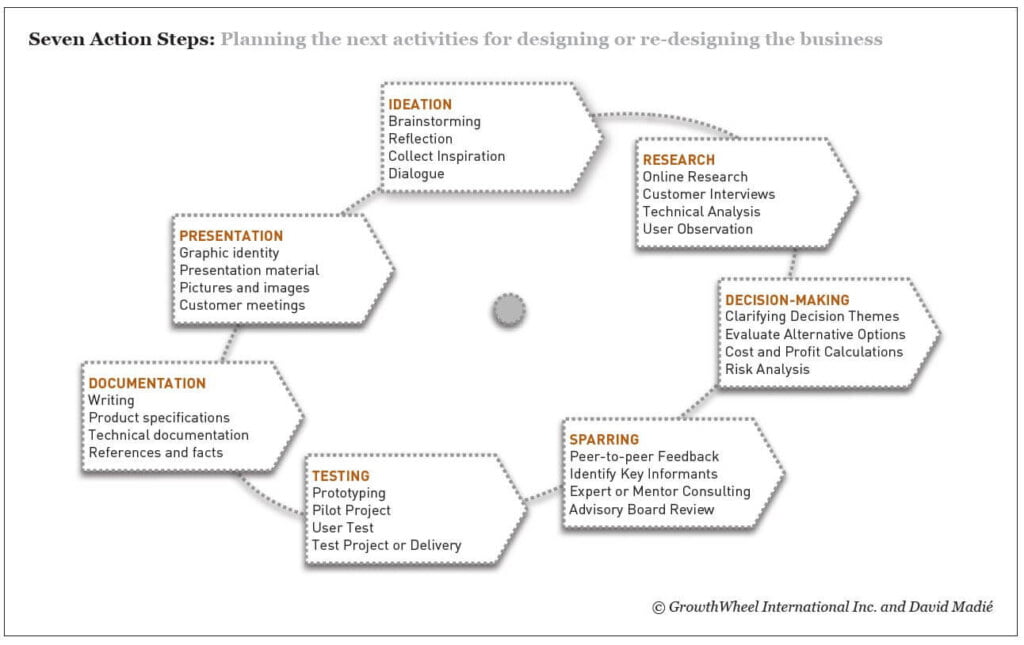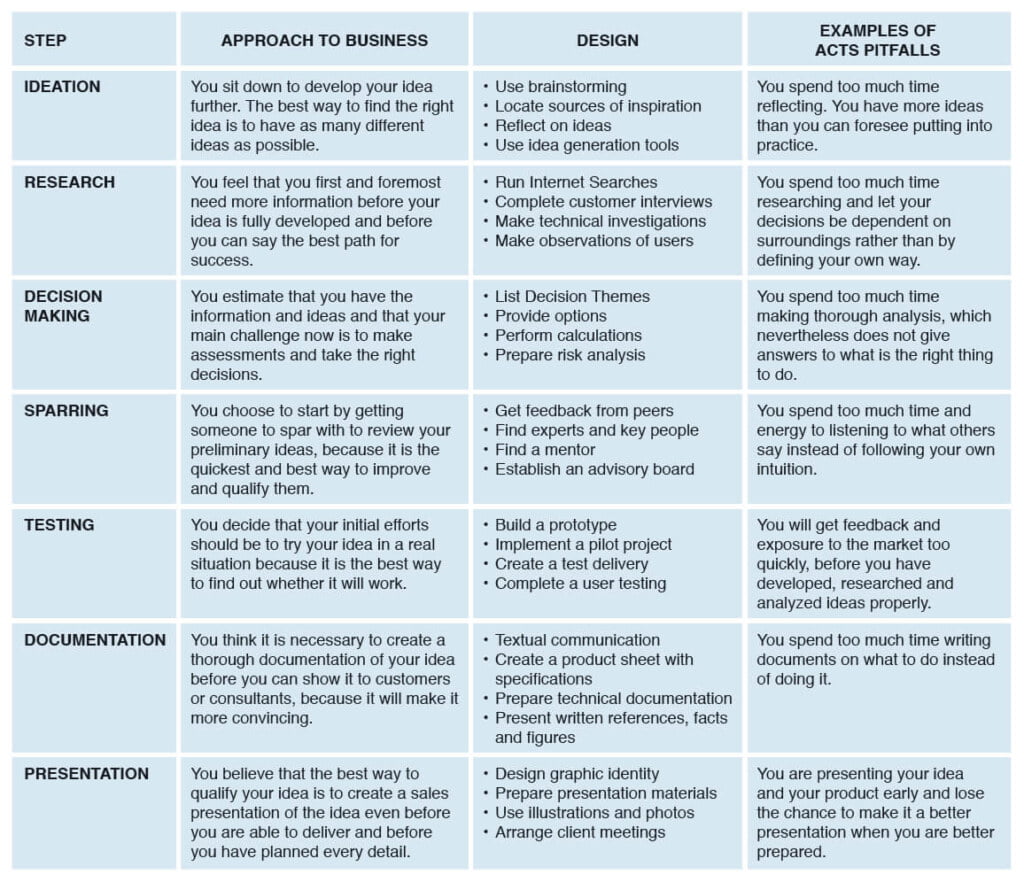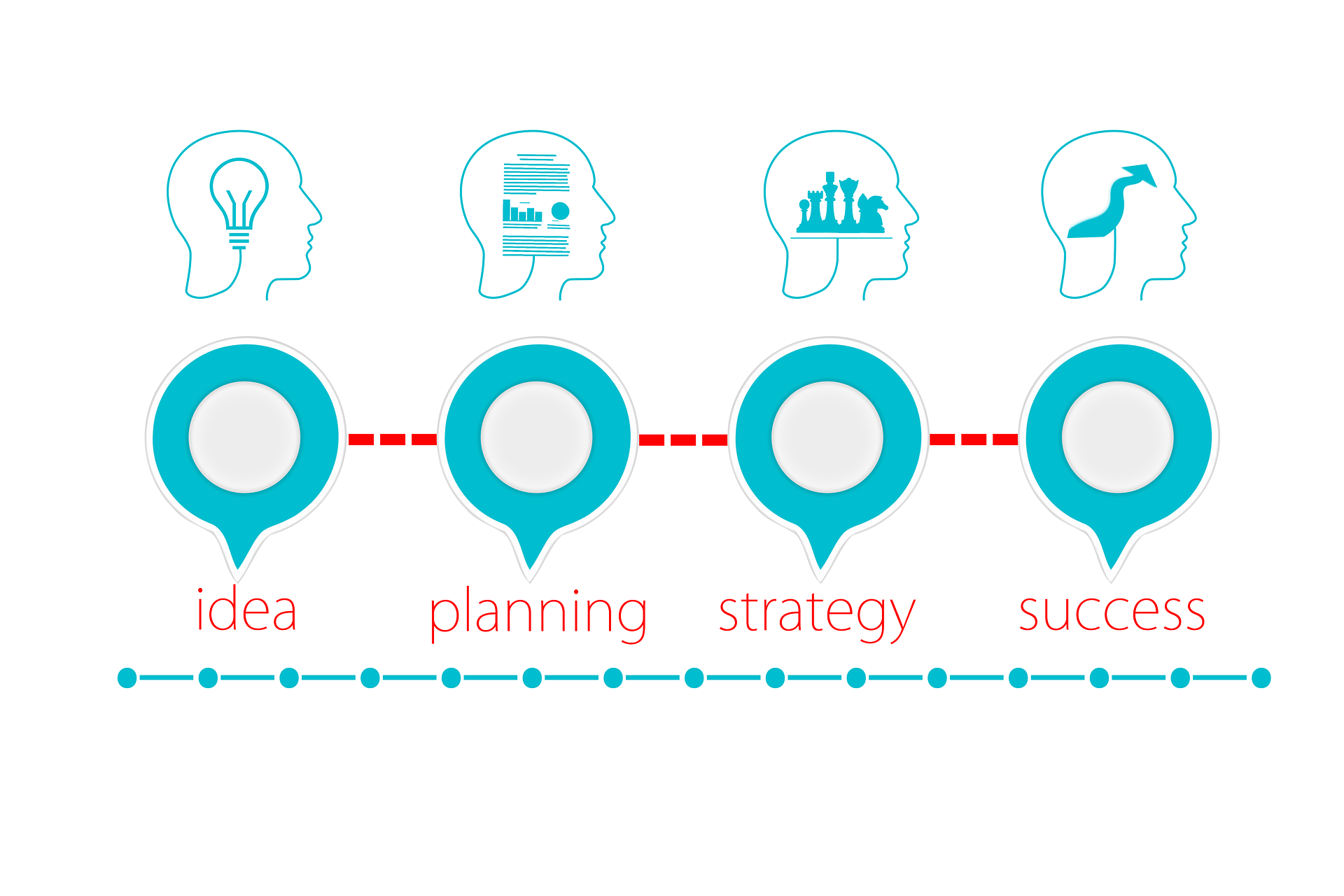7 actions for creative business development
As entrepreneurs we are often encouraged to “work smarter, not harder.” Yet, we also know that we need to do both. We need to make wise decisions, and we must perform a lot of tasks before our business will be successful. So how can we make an action plan that will help us do the right things first?
When we want to start a company from scratch or make it grow, there are – literally – thousands of large and small tasks to perform before our vision can be realized. Less experienced entrepreneurs often think that the most important prerequisite for business success is to have a great idea. More experienced entrepreneurs know that the most important thing is not who has the great idea, but who is capable of carrying it out. It is the ability to act that makes the difference, and therefore one of the most important challenges is to identify the problems that need solving – and to choose which to tackle first, so we can get moving.
Emotional barriers to action However, sometimes there is something holding us back – emotional barriers that prevent us from getting on with the tasks and setting the necessary actions in motion. In worst case, these emotional barriers prevent us from even getting started, or experienced entrepreneurs that already run a business, fail to realize its full potential. There can be many reasons for this. It may be that they simply lack the inspiration to get started, or that they lack sufficient self-confi dence to go ahead, because they just do not know how to perform the tasks. It may also be sheer helplessness when faced with the sheer magnitude of work to do.
The most important thing is not who has the great idea, but who is capable of carrying it out.
While this situation renders some entrepreneurs totally passive, others concentrate on writing a much too long business plan. Writing a business plan can seem like the only way to get an overview of what needs to be done – and if you have been through further education, you have been trained to write long reports and therefore feel at home doing it. However, the danger of writing a business plan is that you forget to act, you forget to initiate the projects or the actions that can get the business off the ground. Writing a business plan is most often a very analytical approach to starting a business.
There is, however, an alternative to the business plan – a creative approach to business development that is about creating business through action.

Seven Action Steps – a creative business development process
One way of getting an overview of what needs to be done is to divide the actions into manageable categories. This is done in the model “Seven Steps for Creative Business Development” which shows diff erent types of action that we can immediately get started with to take our business to a new level. The Seven Steps model illustrates actions that most successful entrepreneurs have taken at some point in their business development.
Step 1: Inspiration for ideation
The first example of what entrepreneurs do when they start a business or generate growth in an already existing business, is seeking ideation. Seeking ideation is important both in the beginning, when developing a business concept, and subsequently, when an idea has to be further developed and improved.
Seeking ideation can be an active brainstorming session internally or with others, resulting in the most possible branches on a mind-map or post-it notes on a poster. We can also be inspired by books, magazines or online media, where we can learn how others got to find new ways of thinking. Finally, seeking ideation can also involve fi nding time and space to reflect on ideas. The right ideas can occur any time, be it in the shower, on the train, at a cafe or in the woods.
If we are in doubt as to how to lift the company to the next level, this step is always a good place to start. After a few minutes we will probably get fresh ideas for actions that we may be keen to get started with immediately and this is the meaning of actively seeking ideation.
Step 2: Research that provides knowledge
If we have already found the right idea – or have too many ideas – it is not ideation we need, but knowledge. Therefore, for many entrepreneurs, the way to create a strong business is to research how best to do something and how others have done this. For the vast majority of industries and products, it is possible to fi nd out what other entrepreneurs have done and thus make our lives easier.
Above all, research involves spending a lot of hours browsing on the Internet. Never before has it been so easy
for us as entrepreneurs to collect information, look at competitors and fi nd the right contacts. When we understand the importance of using this technology, we can both improve the business and avoid making a lot of unnecessary errors.
However, the Internet is not the only research tool available. Some businesses need to do technical studies or make observations of consumers to gain insight into the best way to design products or services; others may carry out customer interviews with potential customers that can identify customer needs, preferences, purchasing patterns, budgets etc.
Just a few hours of research increases our understanding of the field and strengthens our confi dence in relation to choosing the right course of action.
Step 3: Decision-making that leads to action
For entrepreneurs who have already done the work of collecting ideas, knowledge and information from the market,
the next step in a creative business development is to use the new insights to make decisions. Only when strategic decisions have been made, can the business move forward with implementing the tasks.
When we have to make decisions, we must, above all, be clear as to which topics for decision we have on our mental
agenda or on the agenda to be sent out to the Board of Directors, or the Board of Advisors. These can be decisions about anything from the company’s new name, to the composition of the product range or the choice of marketing approaches.
Decision-making can involve an analytical process in which we assess alternative options in more detail, make financial
calculations or run a more in-depth analysis of the risks associated with a particular decision.
If we feel that the company is not developing, it may well be that the lack of decision-making is the problem. In this
case, an agenda of what is unclear can be a good tool to clarify the next steps. If, despite all analysis, we are still not ready to take an important decision, perhaps we should instead look at the 4th step in the creative business development: to spar with others.
Step 4: Sparring that provides improvements
Sparring with others about ideas can often be a shortcut to action. Instead of spending hours and days on research, it is quicker and easier to get in touch with someone who knows the answer. This shortcut to knowledge is especially relevant when it is not possible to qualify or improve the idea through research.
Sparring thus involves making contact with experts or key informants who have the necessary knowledge or know someone who has. We can also spar with our peers, for example other entrepreneurs who know the situation our business is in now. Many entrepreneurs who have enjoyed success, often attribute this to having a mentor at an early stage – an experienced and insightful person who without charge is ready to help with daily decisions. Others acted quickly to establish an advisory board – or a coffee club – and assembled a group of different people who regularly meet and talk about the business.
If you have taken up the challenge of starting a business in an industry where you have no experience or have created
an entirely new product, sparring from the competitive environment is a good place to focus your efforts to improve your business’ vision.
Step 5: Testing that gives realism
Instead of spending time on research, analysis and sparring, some entrepreneurs choose to “just do it.” They get an idea and then put it in motion, not because they expect that the outcome will prove the right thing to do, but because they believe that testing (trial and error) is really the most creative way to develop the idea and the business.
Trying out our ideas in the real world involves various measures, depending on what type of company we have. For
manufacturing companies the task is to develop a prototype in the form of a test version of the product or a model that can show customers the form and functionality. For companies selling knowledge a test might be to implement a pilot project where the customer is informed that he is a test dummy for the product. Other possibilities for trying out the business idea are to make test deliveries or carry out a consumer test, where a number of people are observed while using the product or asked to fill out a questionnaire Testing in the real world may be the best way to get creative input to develop the business concept further, and testing can sometimes be much more effective than extensive research.
Step 6: Documentation that gives conviction
Instead of testing an idea in the market, some entrepreneurs choose to make a written explanation of their idea. Documentation can be based on ideation, research, decisions, sparring and testing, but it can also be the first step in the thought process as a creative way to clarify ideas. The documentation of the business idea may be in the form of a traditional business plan that is written for potential investors or banks, but it makes more sense for the company’s development to spend time on producing documentation for its customers. With documentation we become more convincing – to customers, partners, investors etc.
“To do creative business development you have to do it all, do it in the right order and do it well.”
Creating documentation involves putting different types of information about the company and products in writing.
For customers, this can be product specifications or technical documentation that can provide the customer with facts
about what the company delivers. Documentation may also comprise formulating texts to be used in different forms of
communication with customers, including the company’s website, brochures or project descriptions.
If we need to convince others about the quality of our business vision, products and services, we can produce this
documentation and consider whether the documentation can be improved by first performing any other of the five preceding steps for creative business development.
Step 7: Presentations that sell
An old proverb states that “you should not sell the skin until you have shot the bear.” Nevertheless, this is something that entrepreneurs often do, and they get away with it. It happens when an entrepreneur arranges meetings with clients before the idea is fully developed, or before he is ready to deliver – something that is easily done, as long as the customer realizes that “the bear will not be shot” until the orders for skin have been placed.
When we make a presentation to a potential customer, we can choose to begin by developing a graphic identity. This
involves everything from designing the logo and business cards to the preparation of templates for product sheets and
other sales materials, and – for the most professional – to select the type of artwork and photoshop styles to support the company’s image.
If we are in a situation where the business idea cannot be launched before we know whether customers will buy,
it makes sense to start by making a sales presentation – a presentation that is so good that customers cannot say no to
placing an order, even though the product has not yet been developed or produced.

Choose your own order and priorities
The Seven Steps of Creative Business Development are presented here in random order – that means that there is no
recipe for what we must begin, continue and end with. It is up to us to prioritize tasks according to our temperament and intuition. It is not even necessary to complete all seven stages of the business development process. However the Seven Steps help with inspiration in areas we have not considered and to create a support structure for our creativity. We often become most creative when we use a framework that lets us explore our ideas within a structure.
Seven Pitfalls
While the seven steps can inspire us to develop important actions that move our businesses forward, they also contain
dangerous pitfalls. Instead of resulting in creative businesses, they can result in a complete standstill. This happens
when instead of taking action at different stages, we immerse ourselves too much in one area:
If we focus too much on inspiration, we may be left with more ideas than we can put into practice. Similarly, we can
drown in research, if we try to get certainty about everything.
Excessive focus on taking many quick decisions can be a problem if we end up taking bad decisions due to lack
of complete information. We can even get too much sparring, we can undermine our own intuition and confidence
if we listen too much to what others say. If we listen too much to our own intuition and start testing our ideas before
they have been thoroughly developed, we might end up losing credibility with the customers. By attempting to be
persuasive by having thorough documentation, we may end up spending too much time writing about the idea, instead of performing it. Finally, we can focus too much on making a good presentation, and forget to develop a good product and thus appear untrustworthy.
The point of this list of pitfalls is that to do creative business development we have to do everything, do it in the right
order and do it well. It is not difficult to do this, we know this because many other entrepreneurs have done it and
succeeded.
Suggestions for the next step
• Assess what type of action you need to start up next.
• Create a series of lists of activities you will implement in each of the seven steps.
• Go ahead. Action beats planning any time.
© GrowthWheel International Inc. and David Madié
Dr Kenneth Moodley is a GrowthWheel Certified Business Advisor and can therefore help you in your entrepreneurial journey towards building a sustainable and profitable business.





